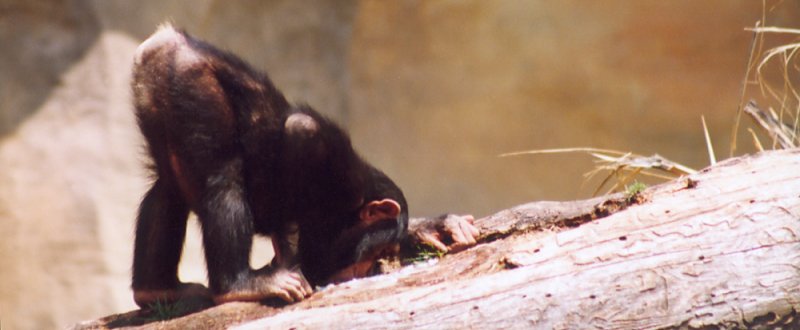Chimpanzee
Pan troglodytes (Blumenbach, 1799)
Taxonomy
Several subspecies of the Common Chimpanzee have been recognized:
- Pan troglodytes troglodytes
- Central Common or Black-faced Chimpanzee, found in Cameroon, the Central African Republic, Equatorial Guinea, Gabon, the Republic of the Congo, and the Democratic Republic of the Congo
- Pan troglodytes verus
- Western Common or Pale-faced Chimpanzee, found in Guinea, Mali, Sierra Leone, Liberia, C�te d'Ivoire, Ghana, and Nigeria
- Pan troglodytes vellerosus
- West Nigerian/East Cameroon Chimpanzee, found in Nigeria and Cameroon
- Pan troglodytes schweinfurthii
- Eastern Common or Long-haired Chimpanzee found in the Central African Republic, the Sudan, the Democratic Republic of the Congo, Uganda, Ruanda, Burundi, Tanzania, and Zambia
Chimpanzees are now incuded in the subfamily Homininae, along with gorillas and humans. They are the closest living evolutionary relatives to humans, with 98 to 99.4% of their DNA in common.
Physical Description
- Head/Body Length: 816mm (32.1in)
- Weight: F - 32-47kg (70.5-103.6lb) M - 40-60kg (88.2-132.2lb)
Their bodies are covered by a coarse dark brownish black hair, except for the face, fingers, toes, palms of the hands and soles of the feet. Either sex may have a white beard and some have a gray back. Infants have a white marking on their rump, and pink skin that darkens more to black with age. Both their thumbs and their big toes are opposable.
Locomotion
Quadrupedal knuckle walking and running, climbing, leaping, suspension, limited brachiation, and occasional bipedalism.
Habitat
Common chimpanzees inhabit the woodland savannas, grasslands, and rainforests of western and central Africa, including areas with elevations greater than 3000m (9843ft).
Diet
- Fruit: 45-76%
- Leaves: 12-25%
- Flowers: 1-18%
- Seeds: 1-11%
- Animal Prey: 0-5%
Chimpanzees are omnivorous. They feed most often on fuit and other plant parts, supplementing these with insects. Chimpanzees will also hunt small prey, including bushpigs, leopard cubs, and monkeys.
Development
- Infant: 5 years
- Weaning: 4 years
- Juvenile: 5-8 years
- Subadult: 8-12 years
- Sexual Maturity: F - 11 years, M - 13 years
- Estrus: 36 days
- Gestation: 240 days (8 months)
- Birthing Season: year-round with a peak between October and November
- Birth Interval: 5 years
- Life Span: 53 years
Social Structure
- Group Size: F - 7-25, M - 5-16, up to 75, usually groups of 4 for foraging
- Home Range: 1250ha
- Day Range: 3900m
Fission-fusion grouping with a group of related males defending the territory. Females are more likely to leave their natal group than males. Males are dominant over females, each having their own hierarchies. Females spend more time alone (with their offspring) than males (up to 65%).
Behavior
Diurnal, arboreal, terrestrial. Most frequently travel on the ground, yet will often feed in trees.
Chimpanzees rocked our definition of what makes humans human with the discovery by Jane Goodall that they not only use objects as tools, but modify them for specific use. Some tools observed: sticks for termite fishing, leaves for sponges, hammers, anvils, and weapons. Chimpanzees also have different cultural traditions from group to group. Cooperativ ehunting, medicinal plant use, and termite fishing are all examples, passed on from generation to generation.
Chimpanzees are one of only three primate species that hunt (the others being capuchins and humans). While their "hunting parties" are not as complex as humans, they are much more ordered than the capuchins free-for-alls. Males and females participate in the hunt, the object of which may be a small primate or even an antelope. Often a group of chimps will drive the prey into an awaiting group who will chase it up a tree, if arboreal, and kill it with rocks, sticks or some other force.
Males form alliances in order to further their group position and in one witnessed instance a number of males from one group formed together to kill a male from another group.
Males aggressive displays including hooting, swaying, vegetation throwing, and branch dragging. There have been documented instances of infanticide, some cannibalistic. At the other end of the spectrum, there are also cases of alloparenting of orphaned infants.
Mating may occur away from the group, or become a highly social event involving many individuals. Both males and females have orgasms and offer "bribes" to gain sexual favors.
... This article is incomplete ...
for more information:
Chimpanzee Cultures. Goodall, Jane. (1990). Through a Window: My Thirty Years With the Chimpanzees of Gombe. Goodall, Jane, Hugo Van Lawick (Photog.), Stephen Jay Gould. (1971). In the Shadow of Man.
References:
The background pattern on this page is by squidfingers.
The image on this page was taken by Ula Plosarek and uploaded to stock.xchng. This image is copyrighted. The copyright holder allows anyone to use it for any purpose, provided that such use is in accordance with any usage restrictions designated by the site and/or photographer.
